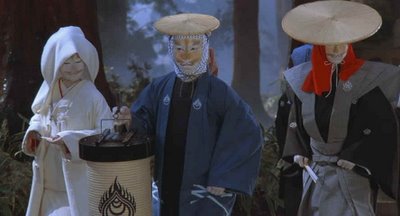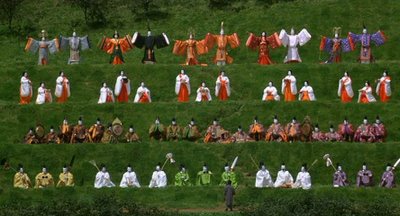Messages are aplenty in Akira Kurosawa’s Dreams [1990]. The movie consists of eight episodes, or dreams, with themes ranging from environment conservation to the humane side of war, the dangers of nuclear power and the ill-effects of nuclear warfare. While some of these messages are very subtly conveyed, some are direct and hit you really hard.
The eight dreams are:
Sunshine Through the Rain.
A young boy witnesses a wedding of foxes.

The Peach Orchard.
A young boy’s family is cursed by spirits for cutting down their peach orchard. The spirits, feeling pity for the young boy, perform a ‘peach blossoming’ ritual for him.

The Blizzard.
Four mountaineers are trying to reach camp during a blizzard. Will they?
The Tunnel.
An army commander is returning home after the war. He has to pass a tunnel to get home. Will his life be the same again after the encounter at the tunnel?
This dream reminded me a lot of the Wilfred Owen poem “A Strange Meeting”.
Crows.
An amateur artist gets inside Vincent Van Gogh’s works and ends up meeting the man himself.
This episode boasts of some absolutely gorgeous visuals. Noted film-maker Martin Scorsese plays Vincent Van Gogh.

Mount Fuji in Red.
An accident occurs at the nuclear power plants, causing Mount Fuji to erupt. Poisonous gases all over the air. Chaos everywhere. What’ll happen to man?

The Weeping Demon.
Featuring monstrous dandelions and man-turned-demons that eat each other to survive, this is a chilling tale about the effects of nuclear war.

Village of the Watermills.
A city-bred comes to a very scenic village where man lives in harmony with nature. A dream about environment conservation.
-
Dreams is a visual delight. Never before have I seen such an exquisite display of color. Never have I seen color exploited like this. The breath-taking locales often leave the viewer gasping in awe. Crows and Village of the Watermills are shining examples of this.
The graphics in the movie are simply awesome. Special praise should be given to George Lucas’s ILM Special Effects Group for the effects in the Crows episode.
The overall acting is top-notch. Akira Terao and Martin Scorsese are good in their portrayals. Kurosawa even gets natural performances by the two young boys, who appear in the first two episodes.
The background music and dialogues are minimal. Silence rules. The silence plays a big role in leaving an impression within you. The sound of the trickling of a stream when all is quiet sure does have an effect on you.
The direction by Akira Kurosawa and Ishirô Honda is flawless. Kurosawa captures nature at it’s finest hour, leaving our senses overwhelmed by it’s sheer beauty. He also indulges in a lot of fog, giving the movie a slightly surrealistic feel. Ishirô Honda directed “The Tunnel”, “Mount Fuji in Red” and the prologue and epilogue of “The Weeping Demon” (source: IMDB). The editing is crisp. Lengthwise, the shots are neither too long nor too short, but just right. One second less and the buildup would be incomplete. One second more and the viewer’s concentration would waver.
These dreams, like typical dreams, are left incomplete. Each story is about 10 to 20 minutes in length. Each episode ends in it’s prime, just when the pressure mounts and you get fully engrossed. You are left to imagine the end for yourself. Episodes like The Tunnel, Mount Fuji in Red and The Weeping Demon are thought-provoking and unforgettable because they don’t have an ending.
In short, Akira Kurosawa’s Dreams is a must-watch. The movie and it’s messages linger on within your head for a long time, making you think about what you have just experienced. Dreams is best watched on a lazy Sunday afternoon, when the clouds have just started hinting of rain.
--
© Guru Smaran

No comments:
Post a Comment